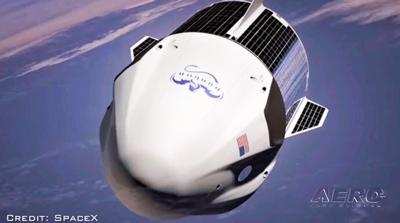Thank You, Mr. Musk
On Saturday, 11 March 2023, a SpaceX Crew Dragon capsule appositely dubbed Endeavour splashed down off Florida’s Gulf Coast, thereby delivering NASA astronauts Josh Cassada and Nicole Mann, Roscosmos cosmonaut Anna Kikina, and Japan Aerospace Exploration Agency (JAXA) astronaut Koichi Wakata safely home to Earth. In addition to bringing NASA’s SpaceX Crew-5 mission to a successful conclusion, the flight further demonstrated the viability of SpaceX’s Crew Dragon platform.

After spending 157 days in orbit, the international crew of four disembarked the International Space Station (ISS) at 02:20 EST on the morning of 11 March. Endeavour maneuvered Earthward, passing through re-entry’s harrowing crucible, all the while decelerating as the atmosphere through which it passed grew increasingly dense. At approximately FL180, as the spacecraft’s velocity slowed to roughly 304-knots, Endeavour’s drogue parachutes deployed, slowing the capsule further still. Less than one-minute later, as Endeavour slowed to some 103-knots and passed through about six-thousand-feet AGL, the craft’s four main parachutes deployed, blooming eerily white against the night sky, and delivered Endeavour and its occupants to a safe 09:02 EST splashdown west of Tampa.
SpaceX recovery vessels retrieved the capsule and its quartet of spacefarers from the Gulf of Mexico and returned them to shore. Endeavour's crew was subsequently flown to NASA’s Johnson Space Center in Houston, where they will undergo physical examinations and be thoroughly debriefed. The Endeavour capsule will return to Florida for inspection and processing at SpaceX’s Dragon Lair, where teams will inspect it within and without, analyze data pertaining to its performance, and begin preparing the spacecraft for its next flight.
Speaking to the subject of the completed Crew-5 mission, NASA Administrator Bill Nelson stated: “Welcome home, Crew-5! This international crew has been conducting critical science experiments and technology demonstrations on the International Space Station that will help prepare us for future deep-space missions and pave the way for our return to the Moon. Each advancement these explorers make is not an achievement for one, but a giant leap for all of humanity.”
NASA’s SpaceX Crew-5 mission lifted off from Launch Pad 39A of the agency’s Kennedy Space Center at 00:34 EDT 05 October 2022. Upon reaching an altitude of approximately 43-nautical-miles, the Crew Dragon capsule separated from the Falcon-9 booster rocket by which it had been borne aloft, and completed the 24.5-hour trek to the ISS autonomously, docking safely at the forward-facing port of the station’s Harmony module.

During their 156.5 days in space, Mann, Cassada, Wakata, and Kikina completed 2,512 orbits around Earth, traveling a total of 57,922,452-nautical-miles. The Crew-5 mission was the first spaceflight for Mann, Cassada, and Kikina. Wakata, conversely, has logged a total of 505 days in space over five separate spaceflights.
The Crew-5 mission’s successful return to Earth followed closely on the heels of the 02 March 2023 launch of NASA’s SpaceX Crew-6 mission to the ISS. Both enterprises are facets of NASA’s Commercial Crew Program, which seeks to develop and mature safe, reliable, and cost-effective transportation to and from the International Space Station and low-Earth orbit in preparation for future manned missions to Earth’s moon and Mars.
 ANN's Daily Aero-Term (04.24.24): Runway Lead-in Light System
ANN's Daily Aero-Term (04.24.24): Runway Lead-in Light System ANN's Daily Aero-Linx (04.24.24)
ANN's Daily Aero-Linx (04.24.24) Aero-FAQ: Dave Juwel's Aviation Marketing Stories -- ITBOA BNITBOB
Aero-FAQ: Dave Juwel's Aviation Marketing Stories -- ITBOA BNITBOB Classic Aero-TV: Best Seat in The House -- 'Inside' The AeroShell Aerobatic Team
Classic Aero-TV: Best Seat in The House -- 'Inside' The AeroShell Aerobatic Team Airborne Affordable Flyers 04.18.24: CarbonCub UL, Fisher, Affordable Flyer Expo
Airborne Affordable Flyers 04.18.24: CarbonCub UL, Fisher, Affordable Flyer Expo




